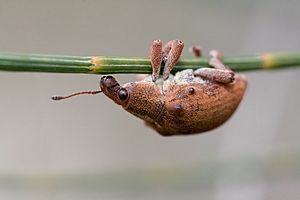Cucujiformia facts for kids
Quick facts for kids Cucujiformia |
|
|---|---|
 |
|
| Gonipterus gibberus on Casuarina sp | |
| Scientific classification |
|
| Kingdom: | Animalia |
| Phylum: | Arthropoda |
| Class: | Insecta |
| Order: | Coleoptera |
| Suborder: | Polyphaga |
| Infraorder: | Cucujiformia Lameere, 1938 |
| Superfamilies | |
|
|
The Cucujiformia is a very large group of beetles. It's like a big family that includes most beetles that eat plants. These beetles are part of an even bigger group called polyphagan beetles.
Contents
What are Cucujiformia Beetles?
Cucujiformia is a scientific term for a specific "infraorder" of beetles. An infraorder is a way scientists group living things. It helps them understand how different animals are related. Many of the beetles you might see in your garden or local park belong to this group.
These beetles are known for their varied diets. While many eat plants, some also eat fungi or other insects. This group is incredibly diverse, meaning it has many different shapes, sizes, and colors of beetles.
Different Kinds of Cucujiformia
The Cucujiformia group is divided into six main "superfamilies." Each superfamily contains several families of beetles. Here are some of the interesting beetles you can find in each:
Chrysomeloidea
This superfamily includes about seven families of beetles.
- Longhorn beetles are known for their very long antennae, which can sometimes be longer than their bodies!
- Leaf beetles are often brightly colored and, as their name suggests, they mostly eat plant leaves.
Cleroidea
This group includes beetles like:
- Checkered beetles often have colorful, checkered patterns on their bodies.
- Bark-gnawing beetles are usually found on trees, where they might feed on bark or other insects living in the bark.
- Melyridae, also called soft-winged flower beetles, are often found on flowers.
Cucujoidea
This is a large superfamily with 32 families.
- Ladybirds (or ladybugs) are probably the most famous beetles in this group. They are often red with black spots and are very helpful in gardens because they eat pests like aphids.
- Fungus beetles are small beetles that feed on fungi.
Curculionoidea
This superfamily has about eight families and includes many types of weevils.
- Weevils are easily recognized by their long snouts. They are often plant-eaters and can sometimes be pests in gardens or farms.
- Snout beetles are another name for some weevils, highlighting their distinctive nose-like mouthparts.
- Bark beetles live under the bark of trees and can sometimes cause damage to forests.
Lymexyloidea
This small superfamily includes the ship-timber beetles. These beetles are known for boring into wood, especially timber used in ships or buildings.
Tenebrionoidea
This is another large superfamily with 30 families.
- Blister beetles are known for producing a chemical that can cause blisters if it touches skin.
- Ant-like beetles are small beetles that often look like ants, which helps them hide from predators.
These superfamilies show how diverse and fascinating the world of Cucujiformia beetles truly is!
See also
 In Spanish: Cucujiformia para niños
In Spanish: Cucujiformia para niños

